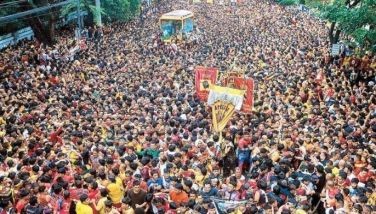NSO achieves major milestones in automation project
December 9, 2002 | 12:00am
Filipinos can now experience the convenience of the request-anywhere capability of the National Statistics Office (NSO).
This, as the NSO marks the first year of operation of its Civil Registry System (CRS) project with a number of significant accomplishments: completion of the first and second phases of its computerization undertaking, and complete conversion of birth records from 1945 to 1999.
The recent opening of the Census Serbilis Center in Lucena City, Quezon — the first provincial outlet — ends the rollout requirements for Phase 2. It also reinforces NSO’s presence in strategic locations around the country.
"The CRS project aims to bring NSO services closer to the public, and to improve the quality of delivery of these services. The completion of Phases 1 and 2 attests to NSO’s determination to accomplish these objectives," says Carmelita Ericta, NSO administrator and civil registrar general.
The establishment of Census Serbilis Centers is part of the 12-year multi-phase computerization project of NSO’s civil registry operations in partnership with Unisys Phils. Inc. under a build-operate-transfer scheme.
These frontline service centers are found in Baguio, Legazpi (Albay), Lucena (Quezon), San Fernando (La Union and Pampanga), Tuguegarao (Cagayan), Cebu, Iloilo, Tacloban (Leyte), Butuan, Cagayan de Oro, Cotabato, Davao and Zamboanga.
Since all Serbilis Centers are online, Filipinos can avail themselves of the full range of CRS services in any of these outlets. These services include issuance of copies of birth, marriage and death certificates, certificate of no marriage record, and authentication of civil registry documents.
To top that convenience, Filipinos can have their requests for copies of birth certificates served within the day for converted birth records. Applications received in the morning can be released in the afternoon of the same day, while those submitted in the afternoon can be claimed in the morning of the following day.
Converted documents are those civil registry records that have gone through the process of conversion — scanned and indexed, and then transformed into digital format and loaded into the CRS database for easier and faster retrieval.
As of last October, birth records from 1945 to 1999, or some 64.246 million birth documents, have been loaded into the CRS database.
This, as the NSO marks the first year of operation of its Civil Registry System (CRS) project with a number of significant accomplishments: completion of the first and second phases of its computerization undertaking, and complete conversion of birth records from 1945 to 1999.
The recent opening of the Census Serbilis Center in Lucena City, Quezon — the first provincial outlet — ends the rollout requirements for Phase 2. It also reinforces NSO’s presence in strategic locations around the country.
"The CRS project aims to bring NSO services closer to the public, and to improve the quality of delivery of these services. The completion of Phases 1 and 2 attests to NSO’s determination to accomplish these objectives," says Carmelita Ericta, NSO administrator and civil registrar general.
The establishment of Census Serbilis Centers is part of the 12-year multi-phase computerization project of NSO’s civil registry operations in partnership with Unisys Phils. Inc. under a build-operate-transfer scheme.
These frontline service centers are found in Baguio, Legazpi (Albay), Lucena (Quezon), San Fernando (La Union and Pampanga), Tuguegarao (Cagayan), Cebu, Iloilo, Tacloban (Leyte), Butuan, Cagayan de Oro, Cotabato, Davao and Zamboanga.
Since all Serbilis Centers are online, Filipinos can avail themselves of the full range of CRS services in any of these outlets. These services include issuance of copies of birth, marriage and death certificates, certificate of no marriage record, and authentication of civil registry documents.
To top that convenience, Filipinos can have their requests for copies of birth certificates served within the day for converted birth records. Applications received in the morning can be released in the afternoon of the same day, while those submitted in the afternoon can be claimed in the morning of the following day.
Converted documents are those civil registry records that have gone through the process of conversion — scanned and indexed, and then transformed into digital format and loaded into the CRS database for easier and faster retrieval.
As of last October, birth records from 1945 to 1999, or some 64.246 million birth documents, have been loaded into the CRS database.
BrandSpace Articles
<
>
- Latest
- Trending
Trending
Latest
Trending
Latest
Recommended
































